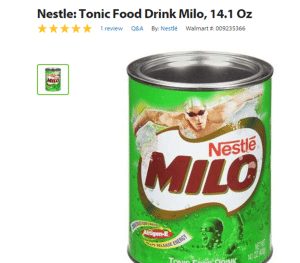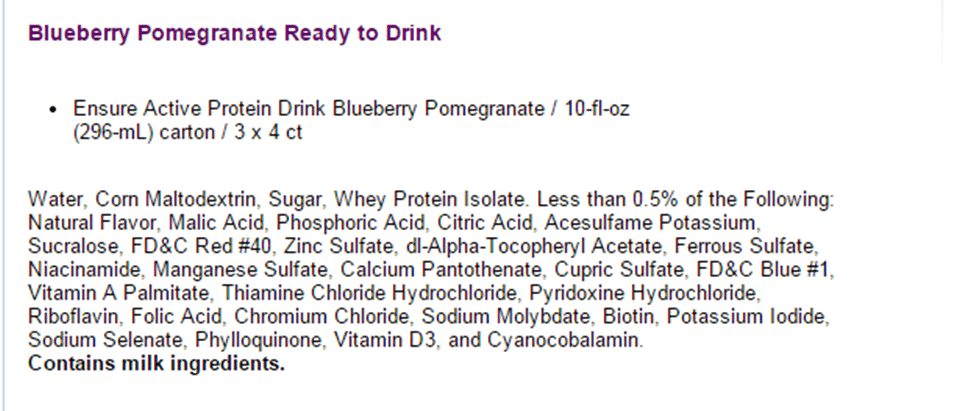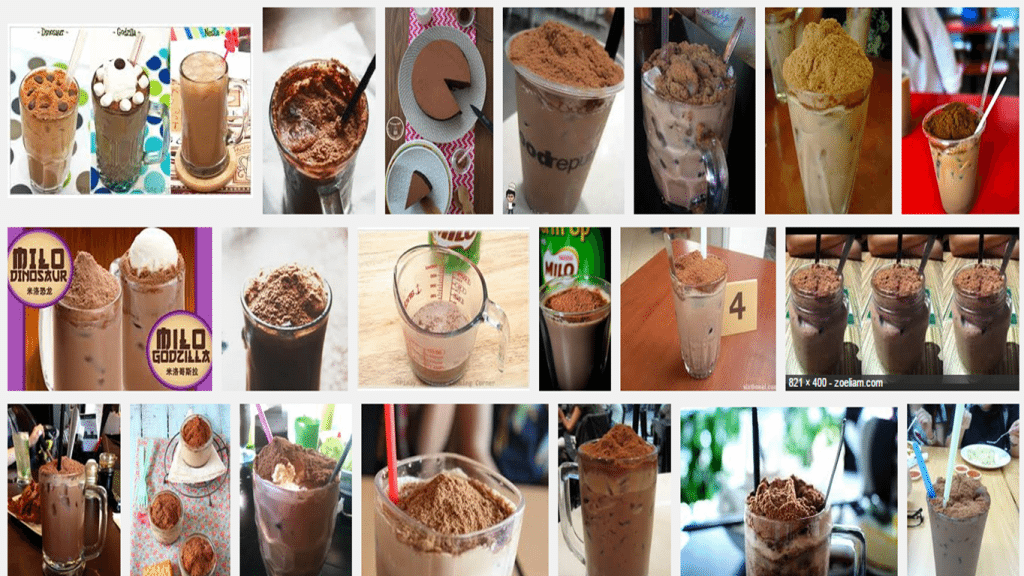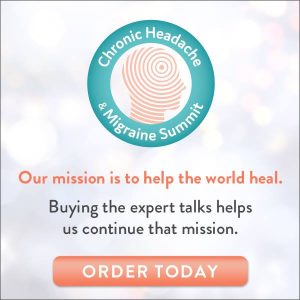Ahh, MILO, chocolaty beverage beloved across the world – that I had never heard of until I arrived in Singapore. I found proof that it does exist in the US (see Walmart ad below), but not being familiar with it, I assumed it was a brand of hot chocolate. Everyone seemed enamored with MILO and said the name with sincere affection. On Friday, I finally asked, what is this MILO drink? Why does everyone seem to like it so much?
“Oh it is a malted milk drink we grew up with and it brings back childhood memories.”
MALTED milk?? Doh! That explains why I was feeling icky all week. Last week, struggling with jet lag, I visited the automated office coffee machine at least twice a day. I didn’t think much of the MILO being in our coffee machine and even mixed it one day with coffee, trying to make it more palatable. I had been starting to suspect the creamer was getting left in the lines and cross contaminating my coffee, but now I realized it was the malted milk that had gluten in it. And indeed, a few days after cutting out the coffee machine, I started to feel better! But I was still curious about the enthusiasm for this product called MILO and decided to read more about it.
The beverage was created in Australia in 1934 and outside of its homeland, it is most popular in Asia, South America, a few African countries and more recently, Canada. In Europe and the US, similar malted milk products Horlicks and Ovaltine ruled the market and ran similar propaganda throughout the 20th century, touting the beverages as important nutrition for growing children. MILO created a strong association as the go-to sports energy drink and many people have stories about Nestle sending the MILO van to kids sporting events in Indonesia, Malaysia and Singapore to distribute it in little paper cups (fostering the addiction at an early age).
Ovaltine was developed in Switzerland in 1904 and is also currently owned by Nestle. Of the three brands, I personally only remember Ovaltine commercials, but I always thought it was a rather unfortunate name and am surprised it was as popular as it was. Originally it was named Ovomaltine (egg and malt), which makes sense, and conveys sort of an honest intention towards making a nutritious product. Interestingly only a few markets including Switzerland and Hong Kong sell Ovaltine without added sugar, yet it continues to enjoy a perception as a health drink with the likes of Carnation Instant Breakfast (also currently owned by Nestle, hm).
The chocolate beverage I remember from childhood was Nesquik. Nesquik launched much later than the malted milk brands, in the 1950s. It was still marketed heavily to children with various characters (depending on what part of the world you lived in), but it featured slightly less of the “health drink” marketing, compared to Ovaltine or MILO that were created during times of scarcity for improving nutrition in children. In 2012 there was some controversy around an ad that highlighted the fortified vitamins and minerals and claimed that Nesquik was part of a healthy breakfast. Although I agree with the opposition, I think it is a little funny that it took until 2012 for someone to find this marketing inappropriate and that the perception of chocolate milk drinks as healthy nutrition supplements continues around the world. The attempted ban was dismissed by the Advertising Standards Agency, sending a message that we will continue to hear about sugary cereal and drinks as part of a healthy breakfast for the foreseeable future.
Something else that I found interesting in my research was that Horlicks and Ovaltine both have a history of being owned at one time by pharmaceutical companies. Abbott is famous for it’s Ensure and PediaSure “nutrition” products. I think it is curious that pharmaceutical companies have such a stake in the “nutrition” field, when at the end of the day these drinks are food products. Horlicks malted milk was invented by a London pharmacist, so that may have something to do with it. If anyone has some insight here, I’d love to hear it.
Let’s take a break from malted milk, which I can believe was at least invented with good intention, and talk about Ensure for a moment. Ensure has the tagline “Targeted nutrition to help fill your nutrition gaps.” Here is a list of ingredients taken by screen grab from the Ensure product website (12/1/14). Do you have a lack of maltodexterin (corn syrup solids) and sugar in your diet? I didn’t think so. How about toxic food dyes and cheap synthetic vitamins in forms that your body may not be able to process? No? Well there isn’t much left except for water and whey protein. If I wanted to drink whey protein, I would research the source and make sure it came from a healthy organic, grass-fed milk source and skip the suspect, sugary drinks.
I didn’t start this blog post intending to rant about the so called nutrition industry, but looking at these ingredient lists has made me sick to my stomach. That people can parade around with a straight face and call this a nutritious beverage with the authority of a white lab coat is either ignorant or criminal. I’m sure there are extreme cases where corn syrup and pure sugar need to be fed to the very ill to sustain life, but these products are being promoted as meal substitutes for healthy people of all ages. I can’t view them as anything more than a liquid candy bar and the problem isn’t that they are available on the market, but rather that they are being labeled as fundamentally nutritious and being heavily marketed towards children (click here for a link to see the ingredients in Pediasure – they were kind enough to add safflower and canola oil to the sugar water!)
Deep breath…
To end on a lighter note, in my lunchtime conversation with my colleagues about MILO, I was introduced to a Singaporean creation called the Milo Dinosaur. Click here to see a typical recipe. As you can see in the photos below, it is essentially a cup of iced MILO topped with several scoops of powdered MILO. This sounds like the product of a child’s creative imagination…or a marketing genius. :0
Sources
Wikipedia articles on Horlicks, Malted milk, Ovaltine, MILO, Nesquik, Nestle
Product websites for Horlicks, Ovaltine, MILO, Nesquik, Ensure, PediaSure





